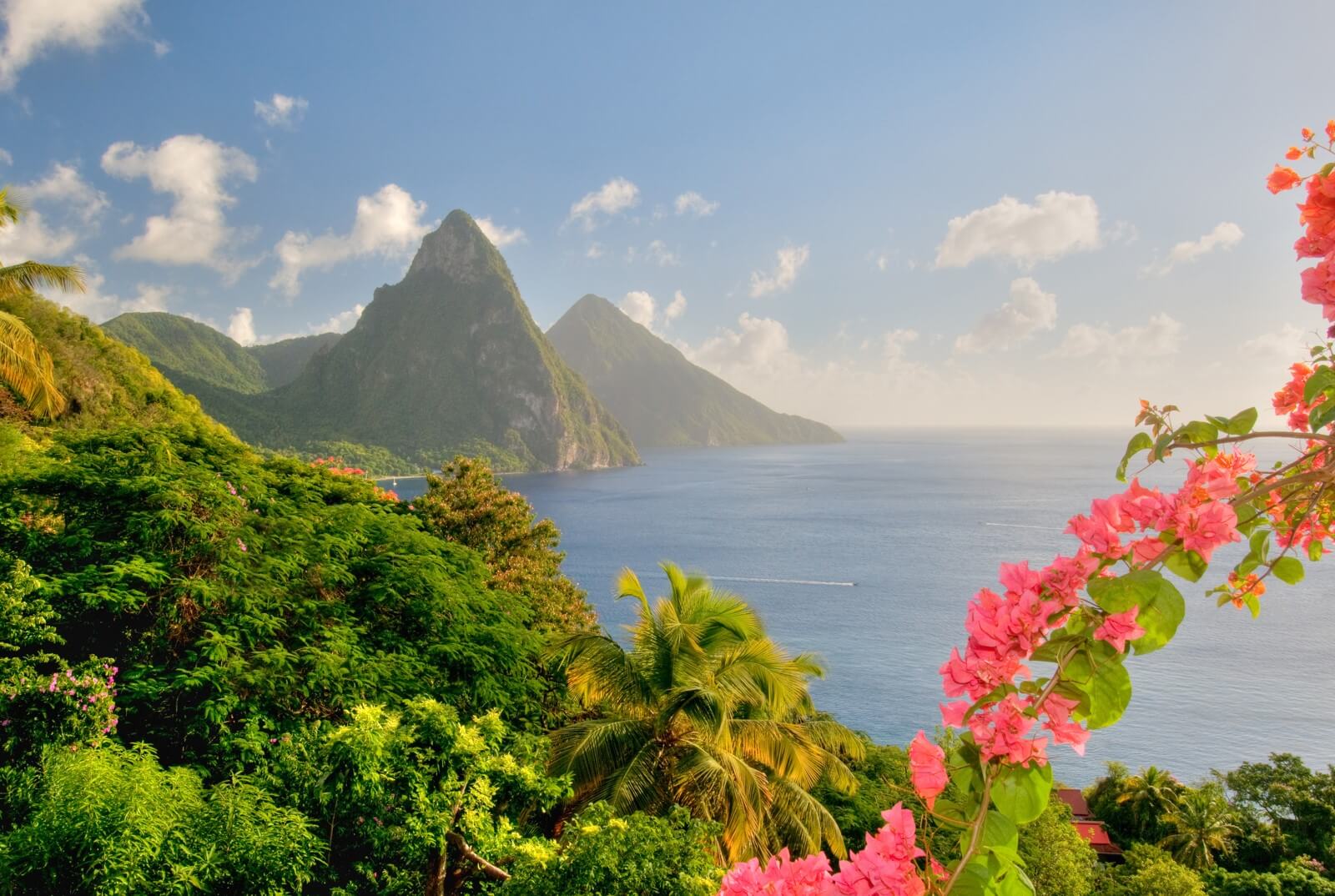St Lucia is a luxe destination characterized by lush rainforests and its rugged landscape, famous for its UNESCO world heritage site, the Pitons – two volcanic spires. The island receives hundreds upon thousands of visitors each year, but when is the best time to visit St Lucia?
If you’re looking for a tropical Caribbean destination with, not only fantastic beaches, but also plenty of wildlife, nature trails and exclusive activities, then look no further. Throughout the year, St Lucia hosts some of the biggest events in the Lesser Antilles, attracting visitors from around the world. Its year-round warm weather and beautiful landscape make it a favorable destination for travelers.
What’s more, our fantastic selection of luxury Saint Lucia villas are destinations in themselves! With far-reaching Caribbean Sea views, private pools and direct beach access from some, our diverse collection of beautiful villas invite groups to kick back and soak up the ultimate vacation.
Book a stunning St Lucia villa rental from $52 per person per night.
The best time to visit St Lucia is March through May. Visitors to the island in these months will still reap the benefits of the dry season with slightly warmer weather as the summer approaches. The tourist hotspots won’t be so crowded, as most cruise ships stop off between December and early March, and you’ll catch these attractions just before most businesses close for the wet season towards the end of June.
However, depending on what you wish to see and do on St Lucia, there may be a better time to travel. Taking a trip in the summer means that you’ll get to see some of the more exuberant festivals the country has to offer. Alternatively, you might choose to join the crowds in January and February, to make the most of perfect weather.
To help you decide you best time to visit St Lucia, we’ve put together a comprehensive guide to the island’s weather and everything you can expect to see on the island throughout the year.
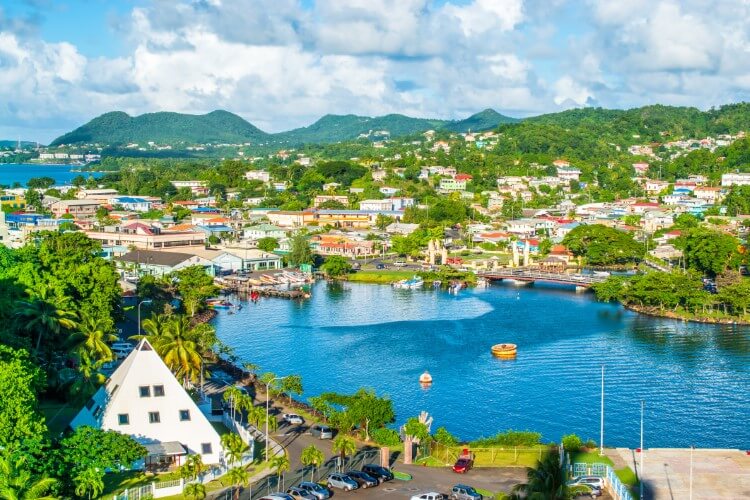
What is St Lucia weather like?
The typical Caribbean island boasts wonderful temperatures all year round with warm, dry winters and hot, rainy summers. With its tropical climate, St Lucia is no exception. That said, due to its impressive elevation, the country does receive heavier and more frequent rainfall than flatter islands, particularly in its mountainous and densely forested areas (that beautiful, lush vegetation has to come from somewhere).
The dry season runs from December through April and experiences significantly less rain than the wet season which follows, from June through November. The humidity is tempered by cooling northeasterly trade winds which creates a relaxing, temperate climate. There’s plenty of time to enjoy this ideal weather as St Lucia receives an average of 8 daylight hours throughout the year
Average temperature in St Lucia
The temperature in St Lucia is fairly consistent throughout the year, varying no more than 5 degrees higher or lower than 80°F (27°C). The lowest temperatures are in January and February, averaging around 79°F (26°C) which is still mild enough to declare the country a wonderful winter sun destination. Temperatures increase throughout the summer to the low 80s (around 28°C), although, as the winds ease off, it can feel a lot muggier and more humid. The island’s hottest month is November at a sweltering 83°F (29°C).
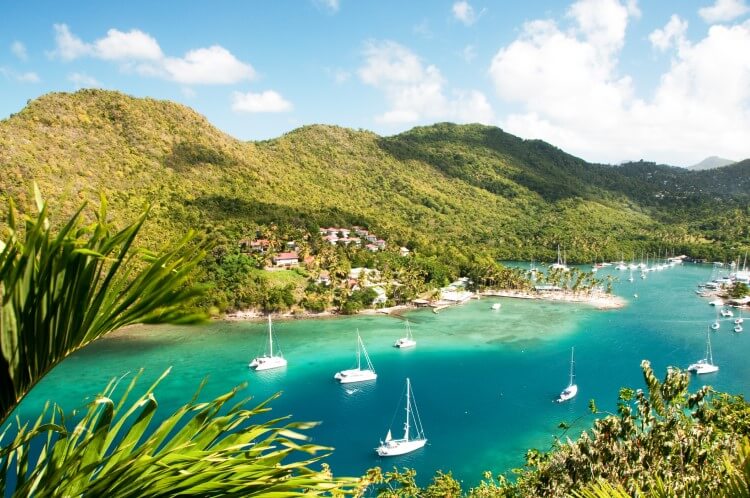
When is St Lucia hurricane season?
The Atlantic Hurricane Season officially runs alongside St Lucia’s wet season from June 1st through November 30th. Despite this, the higher chance of hurricanes actually occurs between August and November. This brings with it hotter weather and heavier rain.
Do hurricanes hit St Lucia?
Hurricane season shouldn’t be a huge cause for concern. It’s very rare for a hurricane to hit an island directly and the likelihood of this happening during your stay is very low. In the last four decades, the country has only been affected directly by a hurricane once, in 2010. The west Atlantic is a vast area so it’s important to remember that a storm in one part of the Caribbean won’t affect the whole region.
Most hurricanes form far north of St Lucia and gain force as they travel west towards the U.S. and Mexico. This means that in the extremely rare circumstance that you encounter a hurricane during your stay, it’s likely to be in its weaker first stages. Historically, St Lucia has seen very few storms higher than category 2.
The island’s Marigot Bay is known, traditionally, to be a hurricane hole – an area where the topography shelters boats from harsh winds. There are a number of hurricane holes throughout the Caribbean, but Marigot Bay is often regarded as one of the best due to the shape of its hills.
Rain season in St Lucia
The wet season on St Lucia marks an increase in thunderstorms and heavier rainfall. If you plan to visit the island at this time, expect short bursts of heavy rainfall in the afternoon. Due to temperatures being higher during the summer, and a decrease in wind speed, these afternoon showers provide a light relief from the muggy climate. It’s uncommon for it to rain constantly throughout the day or multiple days in a row so you’ll still have plenty of time to have fun in the sun. The island even holds some of its bigger events at this time of year.
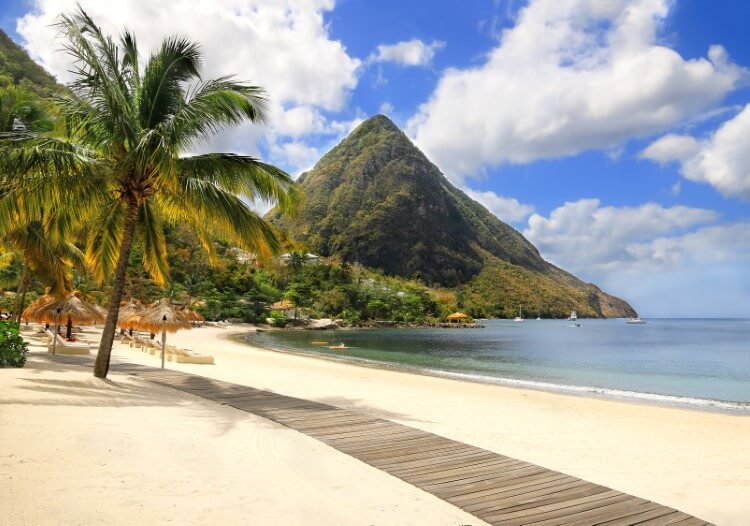
St Lucia’s weather, by month
Excellent January weather in St Lucia
The first month is the most popular time to visit the island. Although January isn’t the warmest month on the island, average temperatures of 79°F (26°C) are enough to attract visitors from the northern hemisphere looking to escape the cold. There is only a small amount of rainfall in this month, averaging around 4.9 inches (125mm). Oddly enough, though, it has as many rainy days (an average of 21) as wet season months such as July or August. This doesn’t deter too many visitors from their plans as rain only falls in short, light bursts. This fantastic feather draws many people to the island, including those from cruise ships, so expect to see many other travelers in the tourist areas.
St Lucia weather in February is ideal
St Lucians continue to enjoy mild temperatures in the high 70s (around 26°C) and dry weather. In fact, with an average precipitation of 3.7 inches (94mm) February is one of the driest months of the year. Visitors in this month also enjoy an extra hour of sunshine, for a total of 9 daylight hours. The island isn’t quite as busy as it is in January, but you’re likely to see a great deal of people enjoying St Lucia as much as you. The first two months have high wind speeds which temper the otherwise humid weather. This does mean that a prolonged dip in the ocean may be a little too refreshing.
Book a stunning St Lucia villa rental in February from $52 per person per night.
March – the best time to visit St Lucia
March boasts some of the best weather of the entire year. It is the driest of St Lucia’s calendar so if you visit during this period, expect a minimal 3 inches (77mm) of average rainfall. Sunseekers won’t be disappointed as March often has the most amount of sunshine, with around 10 hours of daylight. Not surprisingly, the temperatures begin to heat up around 80°F (27°C) so it’s a great time to enjoy a taste of the island’s warmer weather.
The driest months on St Lucia are the most opportune time for scuba diving and snorkeling as the coastal waters have the highest visibility. As there is less river run-off, divers will be able to have a wider view of a thriving underwater world.
March also marks the beginning of turtle hatching season. If you want to spot some baby turtles scooting their way to open waters, it’s important to follow the advice of local authorities so these cute little creatures are protected from interference.
April
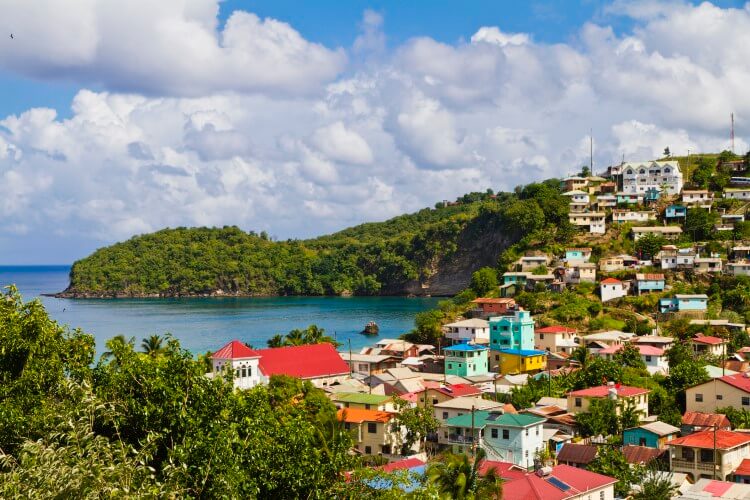
Although the high season comes to an end, and there begins to be fewer tourists on the island, the marvelous weather on St Lucia continues. Temperatures increase to an average of 81°F (28°C) and precipitation levels remain low at around 3.5 inches (89mm).
The near-perfect weather of the early months of the year is great for those wanting to walk nature trails, hike the Pitons and visit the Soufrier Sulphur Springs and many other highlights of a St Lucia vacation. The St Lucia Jazz & Arts Festival is the first of the island’s summer celebrations and generally kicks off late April, so time your stay right and you will be in for a cultural treat!
May
May falls neither in the wet season, nor the dry season. As a connecting month between the two, it bears the benefits of both seasons. If you stay in May, expect warm summer temperatures in the low 80s (around 28°C) and, as such, warmer waters to swim in, averaging 82°F (28°C). Despite May possessing the fewest rainy days of the year (15), showers become heavier and more frequent, drizzling an average of 4.9 inches (125mm). The annual St Lucia Jazz & Arts Festival is also in full swing, until around mid May.
St Lucia weather in June is warm, yet windy
Summer starts as it means to continue with steamy temperatures averaging around 82°F (28°C). However, June has the highest wind speeds, around 17.7mph, which provides tremendous relief from the otherwise humid climate. True to its name, the west season opens with an average of 7.9 inches(200mm) over 20 day in the month.
St Lucia weather in July
As the winds die down, the mean temperature of 82°F (28°C) follows into July and daylight falls to roughly 8 hours. It is also the second wettest month of the year with around 9.6 inches (244mm) of precipitation with afternoon showers expected on 21 days. Although St Lucia’s diverse array of brightly coloured birds can be spotted at any time of year, you’re less likely to see them getting their plumage wet.
August weather in St Lucia is hot
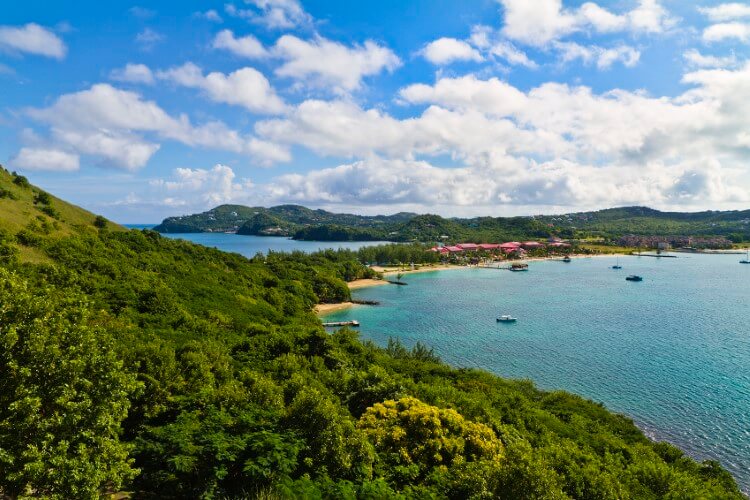
As the wind speed drops to around 13.7 mph (22 km/h), the humidity of the wet season becomes more noticeable. Temperatures remain high in the low 80s (around 28°C) and the sea temperature increases to an average of 84°F (29°C). With 8.1 inches (206mm) of precipitation, August still has a lot of rain. Remember, these afternoon showers offer some relief from the hotter temperatures.
September
For a number of reasons, September is the least popular month and many deem it not the best time to visit St Lucia. At a slow 11.5 mph (18.5 km/h) , wind speeds are at their lowest, meaning that there is little reprieve from the muggy weather. In addition, rainfall increases to around 8.9 inches (226mm), so there’s fewer opportunities to enjoy the 9 hours of daylight this month provides. On the other hand, because of this, many miss out on the Food & Rum Festival.
October weather in St Lucia
Creole Arts & Heritage Month is the wettest in St Lucia’s calendar, with 10.2 inches (260mm) of frequent showers. Meanwhile, the highest temperatures exceed 82°F (28°C).However, there’s plenty to see and do across the island over the course of 8 hours of daylight, and in the evening too.
Weather in St Lucia, November
The Atlantic Hurricane Season ends in November, the hottest month of the year. Temperatures average more than 83°F (29°C) and there continues to be a greater likelihood of storms. Despite this, rainfall does begin to ease off with only 8.5 inches of rain over the course of 20 days.
St Lucia weather in December refreshes the island
December is a popular time for visitors who want to experience St Lucia’s festive celebrations. Reinvigorated wind speeds, around 15.9 mph (25.6 km/h), breathe fresh air into the island, renewing its climate for the upcoming year. It begins to cool, to around 81°F (27°C) and the skies sprinkle only 6.3 inches (160mm) of rain.
Book a stunning St Lucia villa rental in December from $52 per person per night.
When is the best time to visit St Lucia for festivals?
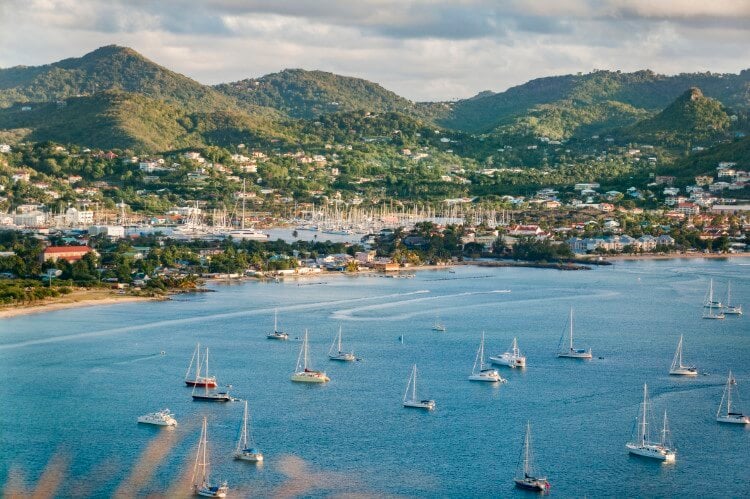
St Lucia is host to some of the most colorful and exciting festivals of the Caribbean calendar. The country prioritizes celebrating its heritage and culture, showcasing its food and music with elaborate parades and parties. You may want to pick your vacation date around one these many vibrant events:
St Lucia Independence Day | February 22nd
St Lucia commemorates the day their island gained independence from the U.K. in 1979. Celebrating over 40 years as an independent nation, St Lucians gather for parades and activities across the island.
St Lucia Jazz & Arts Festival | Late April – mid May
Renowned artists gather on St Lucia for the Caribbean’s most popular jazz event. Experience diverse live performance of jazz, calypso and R&B in a variety of venues across the island. Music will be playing over multiple days and nights.
Fishermen’s Feast (Fête Pêche) | June
The last Sunday of June holds a special place for St Lucian fishermen in particular. St Lucians across the island give thanks for another year of plentiful fishing with great communal lunches, church services and by blessing boats.
St Lucia Carnival | June – July
The island is filled with color and the sound of steel drums. The annual carnival can be the best time to visit St Lucia and it grows bigger and brighter every year. Weeks of competitions, parties, food markets and Calypso music culminate in a phenomenal two-day costumed parade.
Mercury Fest | July
Pigeon National Landmark welcomes thousands of boats from neighboring islands for a massive 2-day beach party. A highlight of the summer in the Leeward Islands, the festival features some of the best local and French DJs for a wild party vibe.
Chocolate Heritage Month | August
St Lucia proudly celebrates its thriving cocoa industry, inviting visitors to tour cocoa plantations, try some of the sweet stuff and indulge in chocolatey spa treatments.
Roots & Soul Festival | August
Popular reggae, hip-hop, Afro-punk, R&B and soul artists arrive on the island for a 3-day music festival of live performances. The event also features encounters with artists and masterclasses for those that want to learn a new talent.
La Rose Flower Festival | August 30th
The first of two traditional flower festivals, “La Rose” is celebrated on the feast day of St Rose of Lima. With ample pageantry, St Lucians show their support of the roses by electing a King and Queen of the fete. The event features processions through the streets and an evening of music and folk dances.
Food & Rum Festival | September
Foodies won’t be disappointed by this 3-day event featuring some of the best chefs on St Lucia. This celebration of a culinary heritage showcases award-winning chefs preparing delicious cuisine with French, British, African and Indian roots.
St Lucia Dive & Adventure Week | September
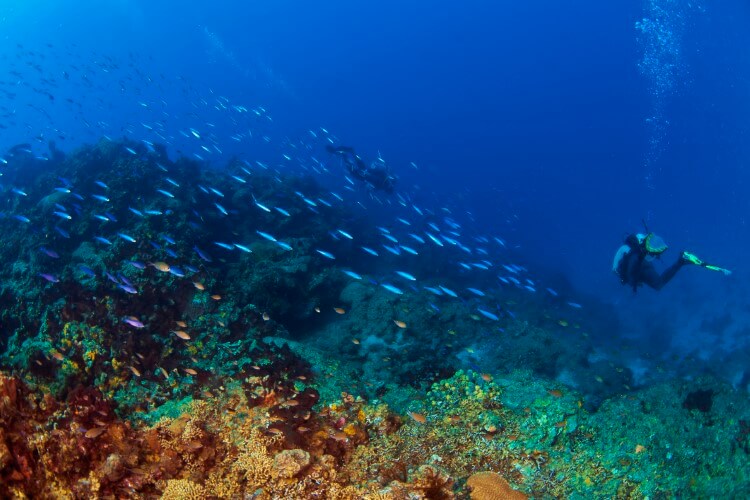
St Lucia is home to some gorgeous coral reefs and abundant marine life. Experience the colorful underwater environments with special scuba and snorkeling activities throughout the week.
Wellness Music Festival | September
Treat your mind and body to the wellness lifestyle with an event that marries live music with wellness – yes, the name says it all. Holistic practitioners, nutritionists and yoga instructors share their secrets to a healthy life, accompanied by artists from around the world who support a wellness lifestyle.
Creole Arts & Heritage Month | October
The best way to learn about St Lucia’s history is by visiting during its month-long celebration of the island’s Creole heritage. Taste authentic Creole and St Lucian cuisine, see locals in colorful traditional dress and dance the night away in a parade on Jounen Kwéyòl (National Creole Day).
La Marguerite Flower Festival | October 17th
“La Marguerite” is the second flower festival held by an alternate society who express dedication to marguerites. It is held on the feast day of St. Margaret Mary Alacoque. Finely, historically dressed locals can be seen parading through the streets and dancing.
Atlantic Rally for Cruisers | November – December
ARC – the largest transoceanic sailing competition in the world is celebrated in Rodney Bay in early December when over 200 yachts arrive from a 2,700 nautical mile journey from Gran Canaria. The island welcomes the yachts with activities and parties.
National Day (Festival of Lights & Renewal) | December 13th
St Lucia celebrated the feast day of St Lucy of Syracuse, the patron saint of light. Festivities to commemorate the triumph of light over darkness begin in the first week of December with lantern competitions and end with a lantern parade, Christmas show and fireworks on the eve of St Lucy (December 12th).
When to book St Lucia vacations?
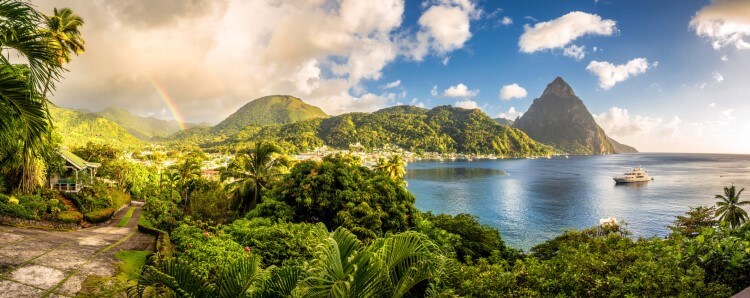
St Lucia is a lovely destination throughout the year, with amazing weather, diverse nature, gorgeous natural landscapes and a bursting calendar of events. The most popular time to visit the island is between December and April due to its dry, mild climate. However, we rate March, April and May as the best time to visit St Lucia. As shown, these months offer some of the driest weather and the most sun, as well as the relief of cooling tradewinds. It’s also a time to spot some beloved wildlife on the island and take part in some of St Lucia’s prominent events, including the annual St Lucia Jazz & Arts Festival.
If you’re looking for a true slice of St Lucia, you may prefer to travel during the summer months.This is when the country comes alive with festivals and cultural celebrations. The island is nourished by rainfall but there’s still plenty of sunshine. Alternatively, you may prefer to avoid the rain entirely, in which case it would be better to travel during the popular months of February and March, as long as you don’t mind busier tourist destinations.
Whenever you choose to visit, St Lucia is a pleasant island all year round.
Looking to embark on your Caribbean adventure? Top Villas has spacious, luxury villas in St Lucia and many other exceptional Caribbean destinations. These homes are bound to make your vacation special.

